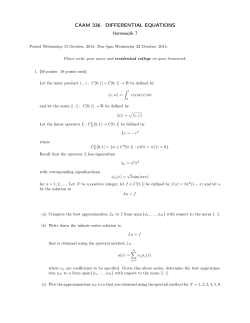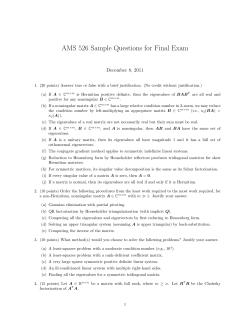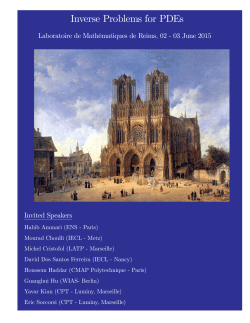
Questions
ACM 40690 Survey of Applied and Computational Mathematics WKB Assignment 1. In the lecture we assumed that our differential equation was in the ‘standard form’ d2 y − V (t)y = 0. dt2 This question shows how we may do that: starting from the differential equation dz d2 z + p(x) + q(x)z = 0, 2 dx dx we need to change both the independent and dependent variables. (a) Show that a change of independent variable to x = x(t) leads to the equation x00 dz d2 z 0 + p.x − 0 + q.(x0 )2 y = 0, dt2 x dt where . denotes that we mean multiplication not function argument. (b) Show that a subsequent change of dependent variable to Z 1 0 00 0 y = z exp (p.x − x /x ) dt , 2 leads to a differential equation of the standard form with V (t) = 14 p2 − q (x0 )2 + 21 f 0 x0 + 34 (x00 /x0 )2 − 12 x000 /x0 where 0 always denotes differentiation with respect to t. 2. (a) Show that the large eigenvalues of y 00 + λ2 q(t)y = 0, are given by λn = nπ y(−1) = 0, y(1) = 0 y(−1) = 0, y 0 (1) = 0 i−1 hR p 1 q(s) ds . −1 (b) Show that the large eigenvalues of y 00 + λ2 q(t)y = 0, are given by λn = (n + 21 )π hR p i−1 1 . q(s) ds −1 (c) Find the large eigenvalues of y 00 (t) + λ2 e2t y = 0, using y(−1) = 0, y(1) = 0 (i) the WKB approximation to terms of order λ0 (ii) the higher order WKB approximation to terms of order λ−1 Compute the relative error for λn given the ‘exact’ values are n 1 2 3 λn 1.282308147 2.637191061 3.983144275 n 10 20 30 λn 13.35704083 26.72773278 40.09546303 4 5 5.325363969 6.665693559 40 50 53.46242832 66.82908492 3. The Airy differential equation is d2 y − xy(x) = 0. dx2 (†) Note: that this just corresponds to Schr¨odinger equation a particle in a uniform gravitational field with V (x) ∝ x for a particle with total energy 0; the region x > 0 is then classically disallowed so quantum mechanically we expect exponential decay while the region x < 0 is classically allowed so quantum mechanically we expect oscillatory solution. (a) Conduct the rescaling x = λ2/3 t (where λ ∈ R+ ) and show that Equation (†) becomes y 00 (t) − λ2 ty(t) = 0. (b) Show that the corresponding WKB approximation to order λ−1 yields y ∼ t−1/4 exp ± 5 −3/2 λt3/2 + λ−1 48 t 3 2 , λ → ∞. (c) Note that for fixed t as λ → ∞ so |x| → ∞ to find the asymptotic solution to the Airy equation as |x| → ∞. (d) Identify the Stokes lines for these solutions (identified informally in this course as the lines along which the ±-solutions are of equal magnitude). 4. Find the WKB approximation to the eigenvalues of normalisable functions satisfying y 00 (x) + (E − |x|)y(x) = 0. (a) Using the results of Section 15.5 compute the WKB approximation to the allowed energy levels: 2/3 3π 1 En = n+ 2 . 4 (b) Letting z = E − x for x > 0 and the corresponding transformation for x < 0 show that the exact solution is given by α Ai(−x − E) x < 0 y(x) = β Ai(x − E) x > 0. (c) Deduce that the exact eigenvalues fall into two classes: (i) α = β and Ai0 (−E) = 0, (ii) α = −β and Ai(−E) = 0. (d) Show that using the following asymptotic expression, derived from Question 3 to order λ0 , in Part (c) reproduces the results of Part (a).: 2 3/2 π −1/4 E + , E→∞ Ai(−E) ∼ E sin 3 4 4pm Thursday, April 23rd 2015
© Copyright 2025










